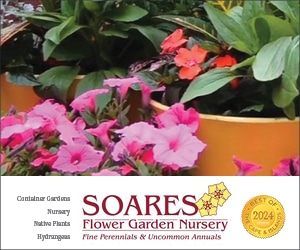
Falling for Foliage
Cape Cod Life / September/October 2013 / Home, Garden & Design, Nature
Writer: Susan Dewey / Photographer: Maddie McNamara
Falling for Foliage

Cape Cod Life / September/October 2013 / Home, Garden & Design, Nature
Writer: Susan Dewey / Photographer: Maddie McNamara
Long after summer’s flowers have faded away, foliage plants keep fall gardens alive with color and texture
September and October are glorious months on Cape Cod and the Islands, when the air temperatures cool down, but ocean and bay waters remain warm. The balmy water all around us means that flowers and shrubs in our gardens stay vibrant with healthy plant life long after gardens over the bridge have gone to sleep for the winter.
Autumnal flowering perennial plants in border gardens such as bold yellow “Black-Eyed Susans,” cool purple Agastache, and rosy-hued Sedum provide color throughout the fall, however, many gardeners have learned that foliage plants—perennials and shrubs planted for the color, shape, and texture of their leaves or needles—are beautiful elements for gardens that often have few flowering plants left after summer’s long blooming period.
Every gardener has their favorite foliage plants from evergreens to ferns to Hostas in nearly every size, shape, and color imaginable. There are certain foliage plants, like Hosta, that boast more than 70 species, from the tiny “Blue Mouse” variety all the way up to the gigantic chartreuse “Sum and Substance,” that can be the backbone of fall gardens, with foliage in an endless array of hybridized choices. Handsome variegated choices like “Patriot” and “Regal Splendor” are available in local nurseries and garden centers with colorations in every shade of green, yellow, blue, and cream.
Hosta are shade-lovers and as such are a welcome addition to gardens underneath trees, along the wooded edges of your landscape, or tucked beneath shrubs in dark gardens. The vibrant foliage of the chartreuse varieties will light up your gardens from spring through autumn, so long as you learn how to control the main enemy of all Hosta plants: slugs. After the first beautiful flush of spring blooming, these nasty slimy creatures arrive with hot summer temperatures and eat ugly holes in Hosta leaves.

Photo by Maddie McNamara
There are all kinds of homegrown ways to control slugs. My personal favorite is filling an empty tuna fish can with beer and placing it under large Hosta, like “Key West”—the slugs love beer and will crawl in and are soon dead-drunk—or you can put coffee grounds around the base of your plants, a texture that slugs do not like. Since slugs love water and piles of decomposing plant debris, keep your gardens as clean as possible and water plants in the morning so your beds have time to dry out before nightfall.
The truth is that despite the slugs, Hosta are incredibly easy to grow and will survive for generations. The large foliage and varying textures of Hosta leaves—some ruffled, some heart or sword-shaped—are far more beautiful than the slender purple or white flowers that appear on the plants in mid-to late-summer. Hosta can also be easily divided and passed along to friends or neighbors. These foliage plants are spectacular performers for fall gardens and will remain a vivid presence in Cape gardens all the way to October.
Another advantage of Hosta is that they can survive Cape Cod’s sometimes wilting mid-summer temperatures without a lot of water, which means you do not need to do a lot of supplemental irrigation or watering. Hosta—like several varieties of fern such as my favorite, the silvery “Japanese Painted Fern”—can make it through an entire summer and fall without extra watering, surviving on the occasional day of rain or light watering with a hose now and then.
The silvery lacy foliage of the “Japanese Painted Fern” is a lovely addition to a bed of chartreuse, variegated, or blue Hosta; these ferns also do not need a lot of water and will look beautiful in shade beds for months on end. The ferns do take a while to get established and will not do well in full sun, but their delicate beauty and muted coloration provide a fine texture and hue to gardens.
“Japanese Painted Fern” can take a few years to reach their full size (about 18 inches to two feet), but once they are established they are one of the most elegant foliage choices available for perennial beds, or foundation plantings. Groupings of these Asian imports around your Rhododendron—especially when paired with a rainbow of Hosta foliages—create a distinctive yet low-maintenance look.
Evergreens—especially the smaller, or dwarf varieties of blue spruce, fir, and cypress—can brighten sunny perennial beds when the last bright flush of flowering plants disappears. Hinoki cypress can be purchased in dwarf varieties like Nana gracilis, their beautiful fan-shaped needles adding a whimsical texture to borders and foundation plantings. When planted adjacent to shady Hosta and fern beds with subtle blue leaves like the “Blue Angel,” the icy blue foliage of dwarf firs like the Glauca compacta creates a pleasing repetitive rhythm, giving a coordinated landscape design. The evergreens also look lovely in snowy winter gardens, their textures and colors a welcome reminder of summer and fall splendor to come.
Cape Cod and the Islands are uniquely suited for grasses like “Japanese Forest Grass Aureola” (Hakonechlo macra), a gracefully arching fountain of boldly striped chartreuse and deep green leaves that loves shade beds, but can also survive in gardens that are not in the sun all day long. Once it is established, “Aureola” grass will live happily in gardens for decades, anchoring the edges and corners of plantings. A wonderful feature of this 2009 “Perennial of the Year” is the sound of the wind rustling through its foliage.
There are some perennials, such as Heuchera and Sedum, that are grown for both their distinctive foliages as well as their flowers. In the last 10 years, there has been an explosion of varieties in the American genus Heuchera, which grows in low mounds of deeply cut and frilled leaves in gorgeous colors from bright gold through chartreuse and on through deep browns and purples. Heuchera’s delicate, wand-like flowers give the plant its common name, “Coral Bells,” but these specimens are planted mostly for their distinctive foliage on the front edge of both sunny and shady gardens.
With names like “Peach Flambe,” “Caramel,” and “Dark Chocolate,” these delicious little beauties provide a delicate frilly edge to perennial gardens all summer long. And after the last “Black Eyed Susan” has closed up for the year in late fall, their foliage provides geometry and texture straight through until frost. Heuchera can be tasty to slugs and insects, but with tins of beer bait placed strategically under large foliage plants and an occasional spray with an organic insecticide like Spinosad, these pretty plants are easy to grow. The 2004 “Perennial of the Year,” Heuchera is a low-maintenance, uniquely effective foliage choice.
Cape and Islands gardeners worth their salt will confess that they love foliage plants as much—if not more—than all the flowering stars of their perennial gardens and foundation plantings. The radiant bursts of color and texture provided by foliage plants brighten even the darkest autumn day easing the regret of our spectacular summer’s passing.
Susan Dewey is the associate publisher and editor of Cape Cod LIFE Publications, a lover of foliage plants, and an occasional designer for Dewey Gardens of Cape Cod.







